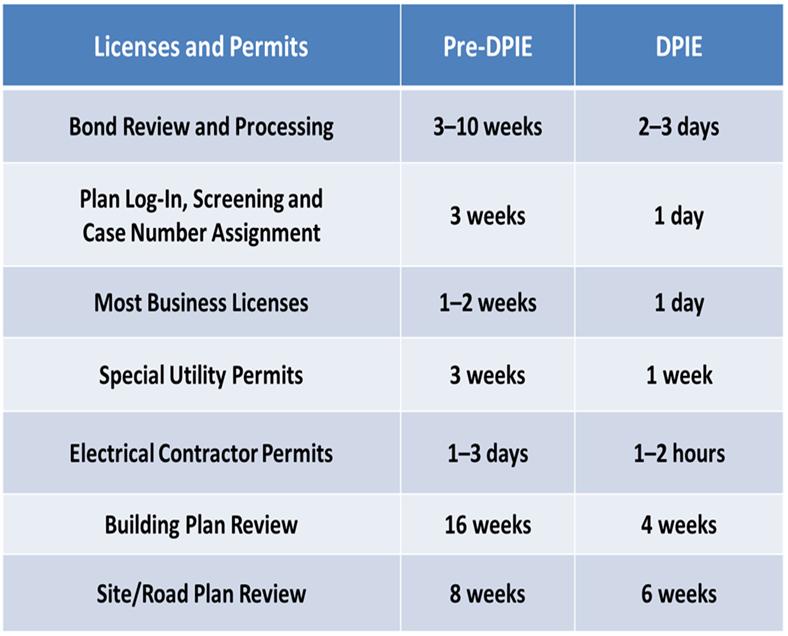Last year at National Harbor, Prince George’s County Executive Rushern Baker told WBC members that Prince George’s County is going to dispel its reputation that it is has one of the most complicated, time-consuming and costly processes for issuing permits and approvals. Mr Baker’s goal was to change the process and become an economic develop engine for the state of Maryland. A major part of that shift has been the creation, in July 2013, of the Department of Permitting, Inspections and Enforcement (DPIE). On June 12, the WBC Regional Development Committee traveled to Largo, Maryland to learn details, successes and challenges regarding this transformation.
Don Dornan, Special Assistant to the Director of DPIE, along with staff members from supporting agencies, provided a first year progress report of how the County goals of providing efficient and effective permitting, inspections and enforcement is being executed. Critical elements involve the creation of a one-stop, high-quality, customer-friendly organization. At 9400 Peppercorn Place, Largo, DPIE merged elements of three PG departments: the Department of Environmental Resources, the Department of Public Works and Transportation, and the Department of Health. Plus, co-location of staff from six agencies (The Park and Planning Commission, Fire & Emergency Medical Services, the Office of Law, the Soil Conservation District, the Washington Suburban Sanitary Commission and the State Highway Administration). Here is a summary of Mr. Dornan’s presentation:
Permitting and licensing in Prince George’s County faced challenges that included authority split among multiple agencies and geographic locations, process duplication, and inconsistent reviews. So within a year of conception, DPIE was establish to “promote economic development and redevelopment…through highly integrated and efficient permitting, inspection and licensing….” Such change requires change, not the least of which is moving beyond prevailing cultures of component agencies, technology starved processes, the redoing of policies and procedures, the development of new budgets and performance criteria. Add to these process challenges, the logistics of physical moves, critical staff shortage and a lack of adequate technology. With these realities, DPIE can boast.
By the time of the WBC visit, DPIE had integrated staffs, relocated key customer services to the 1st floor building level, installed customer amenities, extended service hours, and instituted multiple feedbacks to assess service delivery. The culture shift is critical, with the focus shifting to customers. By policy, all customers are to receive a response within 24 hours. Several new programs assist in this shift. They are the “Peer Review” enabling a 50% faster review for mega commercial projects, third-party reviews of large commercial projects such as National Harbor, and “Plans on File” and “Express Plan Review” which expedited residential building permit and sprinkler systems reviews.
DPIE claims impressive results from pre-DPIE and DPIE process:

DPIE innovations include technological improvements such as the ePermit System which will provide customer on-line access for permits and allow on-line submission of architectural/engineering plans, on-line review by staff, and permit customer tracking of review progress. In fact it is even possible obtain a permit without having to physically visit DPIE. Other technological changes include the Q-Nomy system to automate customer queue management and the processing of CADD and GIS data.
Prince George’s County sits on the cusp of major change. Within the Washington region, it offers the most close-in developable and transit assessable land. Concurrent with this development potential, the county is most in need of a greater employment base to provide jobs to its nearly 900,000 population. The list of Prince George’s County current and mid-term projects is staggering, some $12 billion. They include the buildout of National Harbor, Tanger Outlets, Konterra, MGM Entertainment, potentially the FBI Headquarters, the Purple Line with its associated development, just to site a few. Thus, DPIE is setting much of the governmental institutional structure essential to support this development transformation. Mr. Dornan’s presentation and associated charts specifying Plan and Permit Review responsibilities are available to download.
###
About the Author

Rob Klein
With over 30 years experience in project management, Klein Consulting facilitates redevelopment and entitlements through analysis and outreach. 240-848-4951
